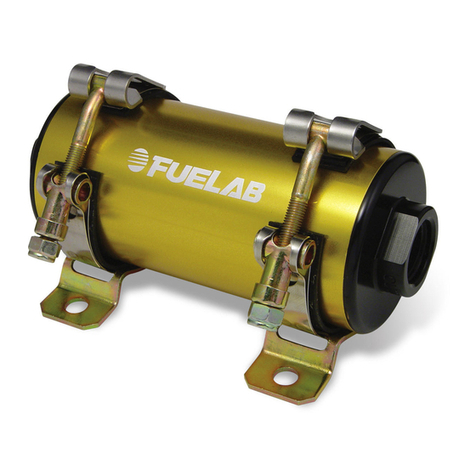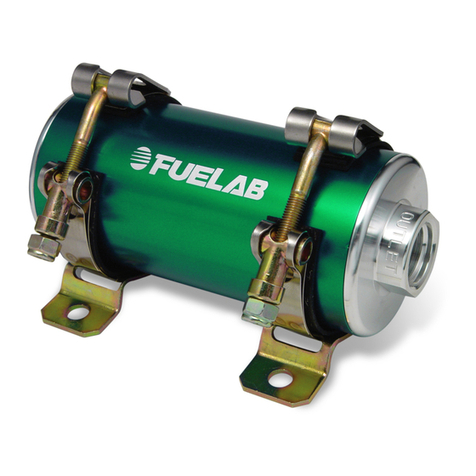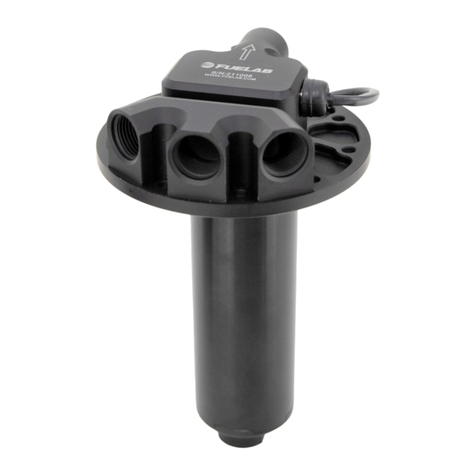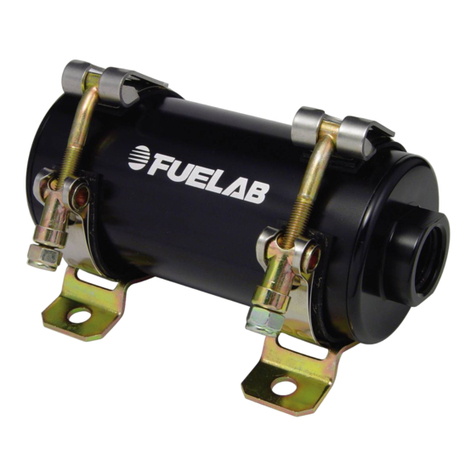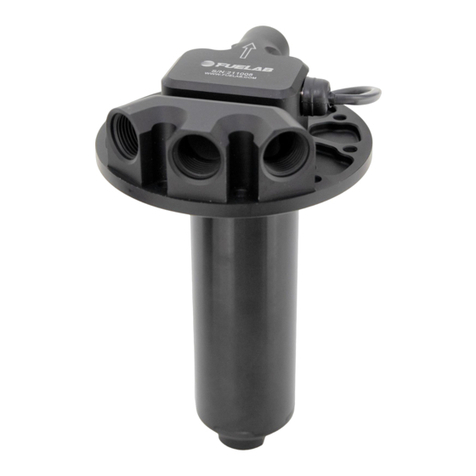
110021251-1, Rev B Sheet 8 of 8
LIMITED LIFETIME WARRANTY
FUELAB, a division of FCP, Inc., having its principal place of business at 1605 Eastport Plaza Drive, Suite 125,
Collinsville, IL 62234, USA ("Manufacturer") warrants its FUELAB products (the "Products") as follows:
1. Limited Lifetime Warranty
Manufacturer warrants that the Products sold hereunder will be free from defects in material and workmanship from the
date of purchase for so long as the original purchaser owns the Products. This Limited Lifetime Warranty does not
extend to any subsequent owner or transferee of the Products. If the Products do not conform to this Limited Lifetime
Warranty during the warranty period (as herein above specified), Buyer shall notify Manufacturer in writing of the
claimed defects and demonstrate to Manufacturer’s satisfaction that said defects are covered by this Limited Lifetime
Warranty. If the defects are properly reported to Manufacturer within the warranty period, and the defects are of such
type and nature as to be covered by this Limited Lifetime Warranty, Manufacturer shall, at its option and own expense,
furnish replacement Products or replacement parts for the defective Products or refund the purchase price. Removal of
Products from vehicle, shipping to Manufacturer and installation of the replacement Products or replacement parts shall
be at purchaser’s expense. (Vehicle means any automotive, bike or marine transportation device powered by an
internal combustion engine to which the Product is attached. This Product is NOT intended or designed for use on
aircraft, experimental or otherwise.)
2. Other Limits
THE FOREGOING IS IN LIEU OF ALL OTHER WARRANTIES, EXPRESS OR IMPLIED, INCLUDING BUT NOT
LIMITED TO THE IMPLIED WARRANTIES OF MERCHANTABILITY AND FITNESS FOR A PARTICULAR PURPOSE.
This Limited Lifetime Warranty does not cover any damage due to: (a) transportation; (b) storage; (c) improper use; (d)
failure to follow instructions for the Products or to perform any preventive maintenance; (e) modification; (f) unauthorized
repair; (g) normal wear and tear; or (h) external causes such as accidents, abuse, or other actions beyond
Manufacturer’s reasonable control. This Limited Lifetime Warranty also does not apply to Products upon which repairs
have been effected or attempted by persons other than pursuant to written authorization by Manufacturer. This Limited
Lifetime Warranty is not extended if we repair or replace the Products.
3. Exclusive Obligation
THIS LIMITED LIFETIME WARRANTY IS EXCLUSIVE. The sole and exclusive obligation of Manufacturer shall at its
option be to repair or replace the defective Products in the manner and for the period provided above or to refund the
purchase price. Manufacturer shall not have any other obligation with respect to the Products or any part thereof,
whether based on contract, tort, strict liability or otherwise.
4. Other Statements
ORAL OR OTHER WRITTEN STATEMENTS BY MANUFACTURER’S EMPLOYEES, REPRESENTATIVES AND/OR
RESELLERS DO NOT CONSTITUTE WARRANTIES, SHALL NOT BE RELIED UPON BY BUYER, AND ARE NOT A
PART OF THE CONTRACT FOR SALE OR THIS LIMITED LIFETIME WARRANTY.
5. Entire Obligation
This Limited Lifetime Warranty states the entire obligation of Manufacturer with respect to the Products. If any part of
this Limited Lifetime Warranty is determined to be void or illegal, the remainder shall remain in full force and effect.
6. Warranty Service
How Do You Get Service?
If something goes wrong with your Product, contact FUELAB at 618-344-3300, or send an e-mail with proof of purchase
to:
[email protected] for
a
Return
Authorization
Num
ber
(R
MA). After receiving your RMA send the product postage paid, fully insured, with a brief written description of the problem to:
FUELAB Warranty Department, 1605 Eastport Plaza Drive, Suite 125, Collinsville, IL 62234
We will inspect your Product and contact you within three business days of receipt to give the results of our inspection
and an estimate of the labor and/or parts charges required to fix the Product, if applicable. If covered under this Limited
Lifetime Warranty, Manufacturer will repair or replace the Product and return it to you at no cost or refund the purchase
price. If the Product is NOT covered under this warranty and if you authorize repairs, we will return the repaired Product
to you COD, or prepaid via credit card, within three business days. If we find no issues with the returned product and it
meets all performance specifications, there will be a $25 charge to cover technician labor and inspection time.
Additional return shipping charges will apply. We will return the repaired Product to you COD, or prepaid via credit card,
within three business days.
Limitation of Liability
THE REMEDIES DESCRIBED ABOVE ARE YOUR SOLE AND EXCLUSIVE REMEDIES AND OUR ENTIRE
LIABILITY FOR ANY BREACH OF THIS LIMITED LIFETIME WARRANTY, OUR LIABILITY SHALL UNDER NO
CIRCUMSTANCES EXCEED THE ACTUAL AMOUNT PAID BY YOU FOR THE DEFECTIVE PRODUCT, NOR SHALL
WE UNDER ANY CIRCUMSTANCES BE LIABLE FOR ANY CONSEQUENTIAL, INCIDENTAL, SPECIAL OR
PUNITIVE DAMAGES OR LOSSES, WHETHER DIRECT OR INDIRECT.
SOME STATES DO NOT ALLOW THE EXCLUSION OR LIMITATION OF INCIDENTAL OR CONSEQUENTIAL
DAMAGES, SO THE ABOVE LIMITATION OR EXCLUSION MAY NOT APPLY TO YOU.
